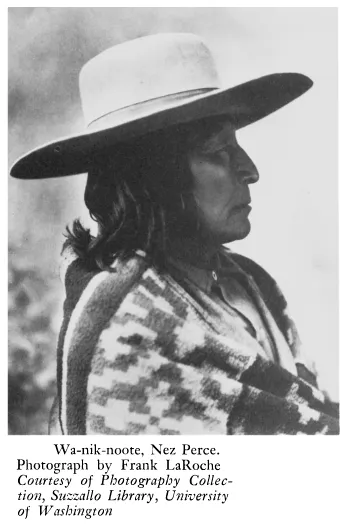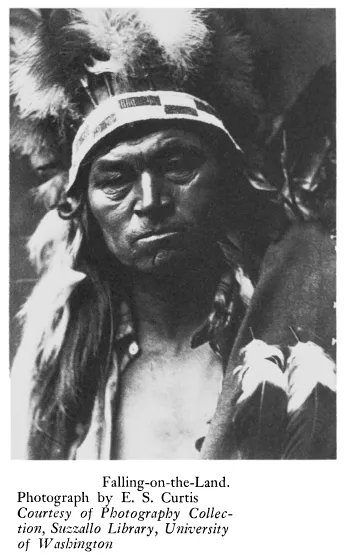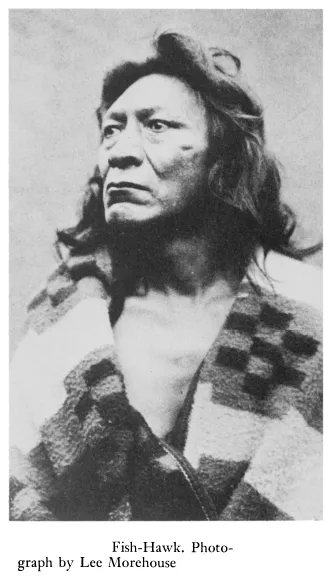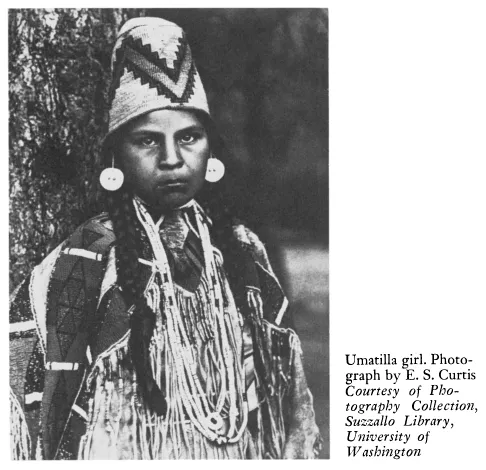
eBook - ePub
Coyote Was Going There
Indian Literature of the Oregon Country
Jarold Ramsey, Jarold Ramsey
This is a test
Share book
- 336 pages
- English
- ePUB (mobile friendly)
- Available on iOS & Android
eBook - ePub
Coyote Was Going There
Indian Literature of the Oregon Country
Jarold Ramsey, Jarold Ramsey
Book details
Book preview
Table of contents
Citations
About This Book
The vivid imagination, robust humor, and profound sense of place of the Indians of Oregon are revealed in this anthology, which gathers together hitherto scattered and often inaccessible legends originally transcribed and translated by scholars such as Archie Phinney, Melville Jacobs, and Franz Boas.
Frequently asked questions
How do I cancel my subscription?
Can/how do I download books?
At the moment all of our mobile-responsive ePub books are available to download via the app. Most of our PDFs are also available to download and we're working on making the final remaining ones downloadable now. Learn more here.
What is the difference between the pricing plans?
Both plans give you full access to the library and all of Perlego’s features. The only differences are the price and subscription period: With the annual plan you’ll save around 30% compared to 12 months on the monthly plan.
What is Perlego?
We are an online textbook subscription service, where you can get access to an entire online library for less than the price of a single book per month. With over 1 million books across 1000+ topics, we’ve got you covered! Learn more here.
Do you support text-to-speech?
Look out for the read-aloud symbol on your next book to see if you can listen to it. The read-aloud tool reads text aloud for you, highlighting the text as it is being read. You can pause it, speed it up and slow it down. Learn more here.
Is Coyote Was Going There an online PDF/ePUB?
Yes, you can access Coyote Was Going There by Jarold Ramsey, Jarold Ramsey in PDF and/or ePUB format, as well as other popular books in Literatur & Nordamerikanische Literarische Sammlungen. We have over one million books available in our catalogue for you to explore.
Information
Topic
LiteraturPart One
NORTHEASTERN OREGON
Nez Perce
Cayuse
Umatilla
Bannock
Wanapum


THE INDIANS who occupied northeastern Oregon before the whites came mingled freely with their fellow Sahaptians along the Columbia, but “at home” they lived a very different sort of life. For home was not centered on a great river, with its bounty of food and traffic east and west, but rather spread out over the great steppes of the Umatilla country, the pine forests of the Blue Mountains, the Alpine crags and high lakes of the Wallowas, and on east into Idaho. Without a river to flow for them, these Indians kept on the move themselves, and their myths and stories reflect the ecology of a nomadic but by no means impoverished life: an awareness of a diversity of landscapes to be traveled through in different seasons, emphasis on hunting and on the big game of the endless hunt—deer, elk, even buffalo.
Chief in fame and power among them were the Nez Perce, expert hunters and expeditioners who ranged over Eastern Oregon and Washington, Northern Idaho, and Montana, but claimed the magnificent Wallowa Valley as their spiritual home. Every nineteenth-century explorer who ventured into Nez Perce country testified to their decency and nobility, beginning with Lewis and Clark, who recuperated among them in September 1805 when westward-bound, and trusted their “Chopunnish” hosts so far as to leave thirty-eight horses and gear with them for safekeeping. In May 1806 the explorers returned from the mouth of the Columbia to reclaim what they had left, and were so well treated during another long visit that Clark was moved to write: “These people have shown much greater acts of hospitality than we have witnessed from any nation or tribe since we have passed the Rocky Mountains. In short be it spoken to their immortal honor, it is the only act which deserves the appelation of hospitality which we have witnessed in this quarter.”1
Both the grateful explorers and their generous hosts would have been dismayed to see, seventy years later, how the course of events had run: now the erstwhile “guests” were demanding that the Nez Perce give up even their sacred Wallowa Valley for white settlement, and move onto reservations. The story of their refusal and subsequent brilliantly executed flight en masse toward Canada under the leadership of Chief Joseph and the gallant Looking Glass has been told and retold, as tragic stories should be.2 Within a decade after Joseph declared to General Miles in 1877 that “from where the sun now stands, I will fight no more forever,” about one-half of his Nez Perce “army”—women, children, old people as well as braves—were dead of sickness and privation, having become displaced persons in Oklahoma Territory as a matter of government policy.
The other tribes and bands ranging in Oregon's northeast quarter were closely related to the Nez Perce, either as mortal enemies, such as the Shoshones and the Bannocks of the Snake River country, or as less powerful allies, such as the Umatillas and the Cayuse. The Cayuse, who struck early explorers as being as mean and surly as the Nez Perce were gracious, gained more than their share of infamy in 1847 when a band of them perpetrated the Whitman Massacre, at the mission of Marcus Whitman and Henry Spaulding near Walla Walla. The Cayuse were able horse-breeders, and today a “cayuse” is a small tough horse of the sort they prized and bred.




The Umatillas are famous nowadays for their colorful annual participation in the Pendleton Roundup; they live, along with some Cayuse, Walla Walla, and Nez Perce, on the Umatilla Reservation northeast of Pendleton. A larger group of Nez Perce lives on the Colville Reservation near Grand Coulee Dam in northeastern Washington, where the survivors of the 1877 uprising were finally re-located, and where Chief Joseph is buried.
Compared to that of the Columbia River tribes, the nomadic pre-white culture of this region is rather sparsely represented to us: very few rock carvings and pictographs, little basketry, a poverty of myths and stories collected from groups other than the Nez Perce. But the Nez Perce, at least, have left a rich, diverse mythic heritage—and it is at once pleasant and historically sobering to imagine Captains Meriwether Lewis and William Clark in some Nez Perce lodge, laughing as the droll tale of Cottontail Boy and Snowshoe Rabbit was translated for them, and then reflecting on the infinitely sad Orpheus story of Coyote in the land of the Shadow People.

Coyote and the Swallowing Monster
NEZ PERCE
COYOTE WAS building a fish-ladder, by tearing down the waterfall at Celilo, so that salmon could go upstream for the people to catch. He was busily engaged at this when someone shouted to him. “Why are you bothering with that? All the people are gone; the monster has done for them.”—“Well,” said Coyote to himself, “then I'll stop doing this, because I was doing it for the people, and now I'll go along too.”
From there he went along upstream, by the way of the Salmon River country. Going along he stepped on the leg of a meadow-lark and broke it. The meadow-lark in a temper shouted, “lιma´, lιma´ lιma´, what a chance of finding people you have, going along!” Coyote then asked, “My aunt! Please inform me, afterwards I will make you a leg of brush-wood.” So the meadow-lark told him, “Already all the people have been swallowed by the monster.” Coyote then replied, “Yes, that is where I, too, am going.”
From there he traveled on. Along the way he took a good bath, saying to himself, “Lest I make myself repulsive to his taste,” and then he dressed himself all up, “Lest he will vomit me up or spit me out.” There he tied himself with rope to three mountains. From there he came along up and over ridges. Suddenly, behold, he saw a great head. He quickly hid himself in the grass and gazed at it. Never before in his life had he seen anything like it; never such a large thing—away off somewhere melting into the horizon was its gigantic body.
Now then that Coyote shouted to him, “Oh Monster, we are going to inhale each other!” The big eyes of the monster roved around looking all over for Coyote but did not find him, because Coyote's body was painted with clay to achieve a perfect protective coloring in the grass. Coyote had on his back a pack consisting of five stone knives, some pure pitch, and a flint fire-making set.
Presently Coyote shook the grass to and fro and shouted again, “Monster! We are going to inhale each other!” Suddenly the monster saw the swaying grass and replied, “Oh you Coyote, you swallow me first, then; you inhale first.” Now Coyote tried. Powerfully and noisily he drew in his breath and the great monster just swayed and quivered. Then Coyote said, “Now you inhale me, for already you have swallowed all the people, so swallow me too lest I become lonely.”
Now the Monster inhaled like a mighty wind. He carried Coyote along just like that, but as Coyote went he left along the way great camas roots and great service berries, saying, “Here the people will find them and will be glad, for only a short time away is the coming of the human race.” There he almost got caught on one of the ropes, but he quickly cut it with his knife. Thus he dashed right into the monster's mouth.
From there he walked along down the throat of the Monster. Along the way he saw bones scattered about and he thought to himself, “It is to be seen that many people have been dying.” As he went along he saw some boys and he said to them, “Where is his heart? Come along and show me!” Then, as they were all going along, the bear rushed out furiously at him. “So!” Coyote said to him, “You make yourself ferocious only to me,” and he kicked the bear on the nose. As they were going along the rattlesnake bristled at him in fury. “So! only towards me you are vicious—we are nothing but dung [?]” Then he kicked the rattlesnake on the head and flattened it out for him. Going on he met the brown bear, who greeted him, “I see he [the Monster] selected you for the last.”—“So! I'd like to see you save your people….”
Thus all along the people hailed him and stopped him. He told the boys, “Pick up some wood.” Here his…friend fox hailed him from the side, “He's such a dangerous fellow, the Monster, what are you going to do to him?”—“So!” replied Coyote. “You too hurry along and look for wood.”
Presently Coyote arrived at the heart, and he cut slabs of fat and threw them to the people. “Imagine you being hungry under such conditions—grease your mouths with this.” And now Coyote started a fire with his flint, and shortly smoke drifted up through the Monster's nose, ears, eyes, and anus. Now the Monster said, “Oh you Coyote, that's why I was afraid of you. Oh you Coyote, let me cast you out.”
And Coyote replied, “Yes, and later let it be said, ‘He who was cast out is officiating in the distribution of salmon.’”—“Well, then, go out through the nose.” Coyote replied, “And will not they say the same?” And the Monster said, “Well then, go out through the ears,” to which Coyote replied, “And let it be said, ‘Here is ear-wax officiating in the distribution of food.’”—“Hn, hn, hn, oh you Coyote! This is why I feared you; then go out through the anus,” and Coyote replied, “And let people say, ‘Feces are officiating in the distribution of food.’”
There was his fire still bearing near the heart and now the Monster began to writhe in pain and Coyote began cutting away on the heart, whereupon very shortly he broke the stone knife. Immediately he took another and in a short time this one broke also, and Coyote said to all the people, “Gather up all the bones and carry them to the eyes, ears, mouth, and anus; pile them up and when he falls dead kick all the bones outside.” Then again with another knife he began cutting away at the heart. The third knife he broke and the fourth, leaving only one more. He told the people, “All right, get yourselves ready because as soon as he falls dead each one will go out of the opening most convenient. Take the old women and old men close to the openings so that they may get out easily.”
Now the heart hung by only a very small piece of muscle and Coyote was cutting away on it with his last stone knife. The Monster's heart was still barely hanging when his last knife broke, whereupon Coyote threw himself on the heart and hung on, just barely tearing it loose with his hands. In his death convulsions the Monster opened all the openings of his body and now the people kicked the bones outside and went on out. Coyote, too, went on out. Here now the Monster fell dead and now the anus began to close. But there was the muskrat still inside. Just as the anus closed he squeezed out, barely getting his body through, but alas! his tail was caught; he pulled, and it was bare when he pulled it out; all the tail-hair peeled right off. Coyote scolded him, “Now what were you doing; you had to think up something to do at the last moment. You're always behind in everything.” Then he told the people, “Gather up all the bones and arrange them well.” They did this, whereupon Coyote added, “Now we are going to carve the Monster.”
Coyote then smeared blood on his hands, sprinkled this blood on the bones, and suddenly there came to life again all those who had died while inside the Monster. They carved the great Monster and now Coyote began dealing out portions of the body to various parts of the country all over the land; toward the sunrise, toward the sunset, toward the warmth, toward the cold, and by that act destining and forenaming the various peoples; Coeur d'Alene, Cayuse, Pend Oreilles, Flathead, Blackfeet, Crow, Sioux, et al. He consumed the entire body of the Monster in this distribution to various lands far and wide.
And now Fox came up and said to Coyote, “What is the meaning of this, Coyote? You have distributed all of the body to faraway lands but have given yourself nothing for this immediate territory.”—“Well,” snorted Coyote, “and did you tell me that before? Why didn't you tell me that awhile ago before it was too late? I was engrossed to the exclusion of thinking. You should have told me that in the first place.”
And he turned to the people and said, “Bring me water with which to wash my hands.” They brought him water and he washed his hands and now with the bloody washwater he sprinkled the local regions, saying, “You [Nez Perce] may be little people but you will be powerful. Even though you will be little people because I have deprived you, nevertheless you will be very, very manly. Only a short time away is the coming of the human race.”
Smohalla's Ghost-Dance Cosmogony
WANAPUM
“ONCE THE WORLD was all water and God lived alone. He was lonesome, he had no place to put his foot, so he scratched the sand up from the bottom and made the land, and he made the rocks, and he made the trees, and he made a man; and the man had wings and could go anywhere. The man was lonesome, and God made a woman. They ate fish from the water, and God made the deer and other animals, and he sent the man to hunt and told the woman to cook the meat and to dress the skins.
“Many more men and women grew up, and they lived on the banks of the great river whose waters were full of salmon. The mountains contained much game and there were buffalo on the plains. There were so many people that the stronger ones sometimes oppressed the weak and drove them from the best fisheries, which they claimed as their own. They fought and nearly all were killed, and their bones are to be seen in the hills yet. God was very angry at this and he took away their wings and commanded that the lands and fisheries should be common to all who lived upon them; that they were never to be marked off or divided, but that the people should enjoy the fruits that God planted in the land, and the animals that lived upon it, and the fishes in the water. God said he was the father and the earth was the mother of mankind; that nature was the law; that the animals, and fish, and plants obeyed nature, and that only man was sinful. This is the old law.
“I [Smohalla] know all kinds of men. First there were my people (the Indians); God made them first. Then he made a Frenchman, and then he made a priest. A long time after that came Boston men, and then King George men. Later came black men, and last God made a Chinaman with a tail. He is of no account and has to work all the time like a woman. All these are new people. Only the Indians are of the old stock. After awhile, when God is ready, he will drive away all the people except those who have obeyed his laws.
“Those who cut up the lands or sign papers for lands will be defrauded of their rights and will be punished by God's anger. Moses [chief of the Sinkiuse] was bad. God did not love him. He sold his people's houses and the graves of their dead. It is a bad word that comes from Washington. It is not a good law that would take my people away from me to make them sin against the laws of God.
“You ask me to plow the ground! Shall I take a knife and tear my mother's bosom? Then when I die she will not take me to her bosom to rest.
“You ask me to dig for stone! Shall I dig under her skin for her bones? Then when I die I cannot enter her body to be born again.
“You ask me to cut grass and make hay and sell it, and be rich like white men! But how dare I cut off my mother's hair?
“It is a bad law, and my people cannot obey it. I want my people to stay with me here. All the dead will come to life again. Their spirits will come to their bodies...